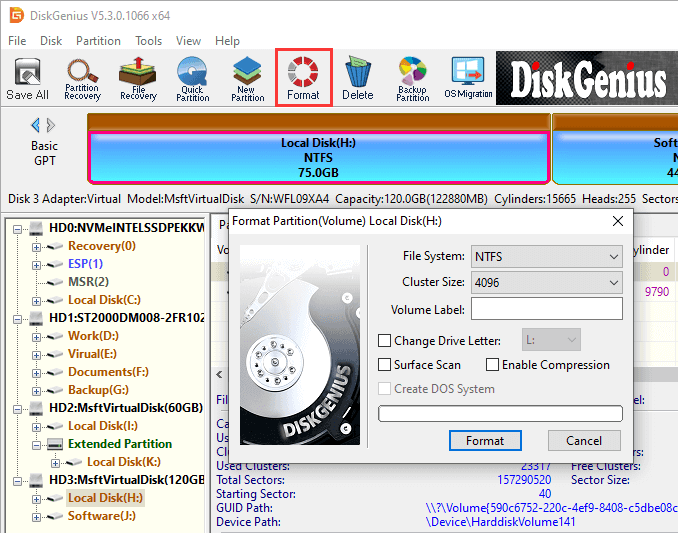Position: Resource - Partition Management - How to Format an SD Card for Your Camera?
Fresh Start: Formatting erases all data on the SD card, giving you a clean slate. This is useful when you've transferred all your photos and videos to your computer and want to reuse the card.
Resolve Errors: If your camera is having trouble reading the SD card, showing error messages like "card not recognized" or having issues saving photos, formatting can often fix the problem. It can clear any file system errors or corrupted data on the card.
Optimize Performance: Regularly formatting the SD card can help maintain its performance. It can defragment the card (in a sense) and ensure that new data can be written to the card more efficiently.
Backup Your Data: This is extremely important. Formatting will permanently delete all the data on the SD card. Transfer all your photos and videos to your computer, an external hard drive, or a cloud storage service before proceeding.
Check the Write-Protect Switch: Some SD cards have a physical write-protect switch. Make sure this switch is not in the "lock" position, as it will prevent the card from being formatted.
Ensure Compatibility: Check the camera's manual to confirm the type of SD card it supports (e.g., SD, SDHC, SDXC) and the recommended file system for formatting. Most cameras support the FAT32 or exFAT file systems.
Step 1. Insert the SD Card: Turn off your camera. Locate the SD card slot on your camera (it's usually clearly labeled). Insert the SD card into the slot, ensuring that it is inserted correctly (the metal contacts of the SD card should be facing the appropriate direction as indicated by the slot).
Step 2. Power On the Camera: Turn on your camera.
Step 3. Access the Menu: Navigate to the camera's menu. The location of the menu button varies depending on the camera model. It could be labeled "Menu", "Settings", or have an icon that looks like a gear.
Step 4. Find the Format Option:
Step 5. Confirm the Format: A confirmation message will appear asking if you're sure you want to format the card. This will delete all data on the card. Select "Yes" or "OK" to proceed.
Step 6. Wait for the Process to Finish: The camera will start formatting the SD card. This may take a few seconds to a minute or so, depending on the size of the card and the speed of the camera. A progress bar may be displayed on the camera's screen. Once the formatting is complete, the camera may display a "Format Complete" or "Done" message.
Step 1. Insert the SD card into your computer's card reader.
Step 2. Open File Explorer (Windows).
Step 3. Right-click the SD card.
Step 4. Choose "Format" and select FAT32 or exFAT file system.
Step 5. Click "Start" and wait for completion.
Step 1: Connect the SD card to the computer. Select the SD card to be formatted in DiskGenius, and then click the Format icon on the upper toolbar.

Step 2. Select file system, cluster size, volume label and click Format button.
Step 3. Click Yes when DiskGenius asks confirmation for the operation, and the SD card will be formatted quickly.

Regular Formatting: It's a good practice to format the SD card periodically, especially if you've been using it for a while or if you've experienced any issues with data storage.
Use Genuine SD Cards: Always use high-quality, genuine SD cards from reputable brands. This can help to avoid compatibility issues and ensure better performance.
Avoid Removing the Card During Use: Do not remove the SD card from the camera or the card reader while the camera is turned on or while the computer is accessing the card. This can cause data corruption.
1. Will formatting damage the SD card?
No, normal formatting will not damage the SD card, but frequent formatting may affect the life span.
2. Why can't the camera format?
-SD card is write-protected (check the lock switch on the side)
-Card is corrupted (try replacing the card or using a computer to repair it)
-Camera firmware problem (update camera system)
3. Which is better, computer formatting or camera formatting?
Camera formatting is safer and ensures compatibility.
Computer formatting is suitable for repairing damaged cards, but you need to choose the right file system.
Regularly formatting your SD card is one of the simplest yet most effective ways to maintain your camera's performance and protect your photographs. By following these steps, you'll ensure your memory card works flawlessly every time you press the shutter button. Remember to always backup your images before formatting, and your photographic memories will remain safe while your equipment performs at its best.

DiskGenius is a one-stop solution to recover lost data, manage partitions, and back up data in Windows.
Download